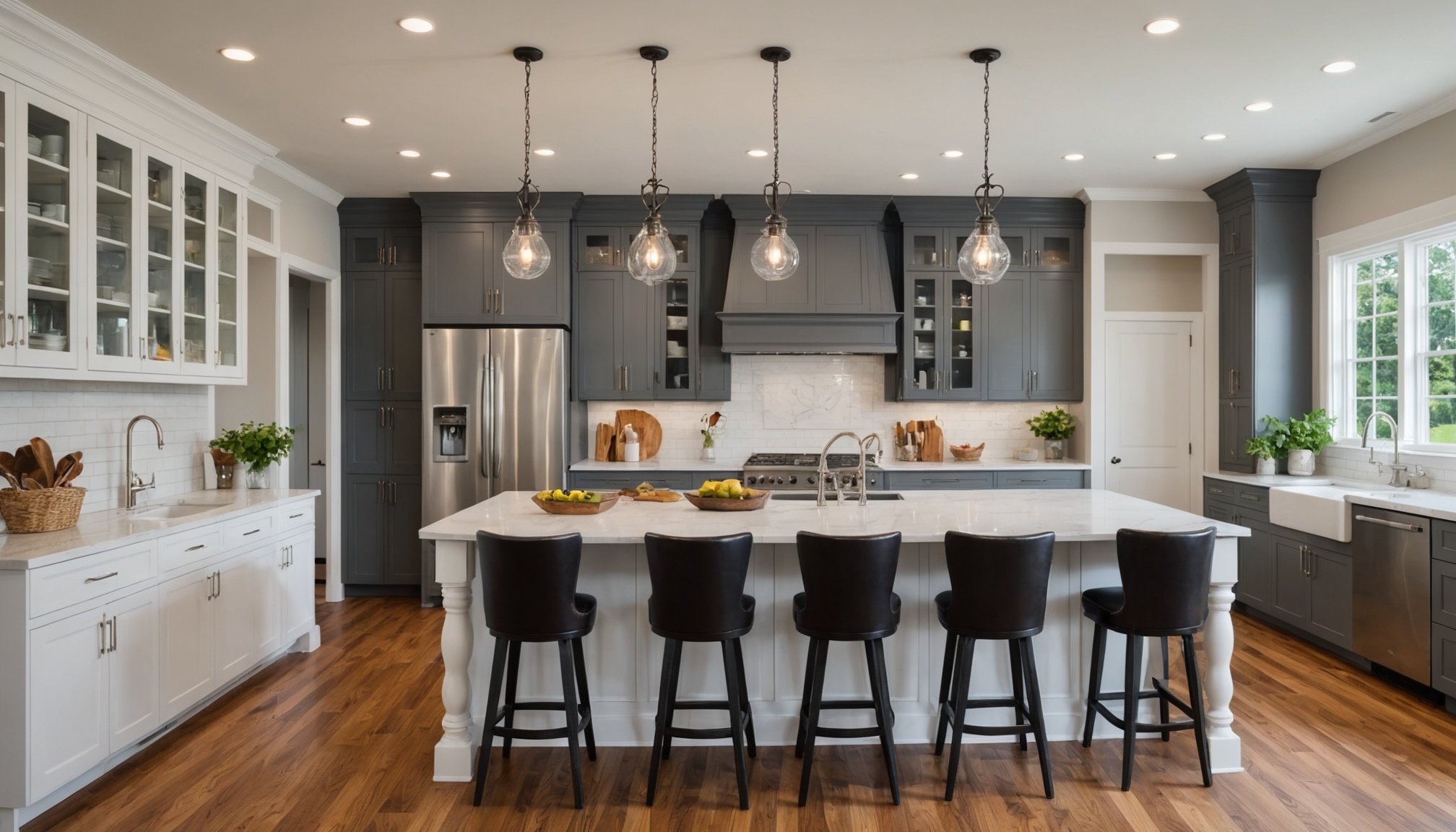Overview of Current Home Renovation Trends
Understanding latest trends in home renovation is crucial for informed decision-making. In 2023, popular renovation styles are heavily influenced by aesthetics and functionality. The year has seen a rise in distinct design styles like minimalist approaches, which prioritize simplicity and decluttering, allowing for open spaces that enhance zen living.
Consumer preferences have significantly shaped these trends. Leaning towards versatile and multifunctional home solutions, there is a preference for designs that meet both aesthetic and practical needs. For instance, the interest in industrial chic styles combines raw textures with sleek finishes, catering to those who appreciate a modern yet rugged aesthetic.
This might interest you : Innovative Home Renovation Tips for Thriving During Uncertain Times
Additionally, the enthusiasm for bohemian interiors reflects a desire for personalized spaces, characterized by their eclectic mix of patterns and diverse, vibrant aesthetics.
Understanding these trends helps homeowners and designers anticipate client needs and make selections that resonate with contemporary desires. Therefore, being in sync with these preferences not only ensures stylish outcomes but also promises functionality tailored to today’s lifestyle demands. It’s this balance between design and utility that drives the success of home renovations in the current era.
Also read : Innovative Eco-Friendly Home Solutions Redefining the Industry’s Future
Popular Design Styles
In the realm of home renovation, understanding the design styles that captivate consumer interest is essential. Today’s trends are largely driven by a desire for spaces that are both visually appealing and practical.
Minimalist Design
With a focus on simplicity, minimalist design emphasizes clean lines and open spaces. This style encourages decluttering, creating environments that promote relaxation and enhanced functionality. Visual harmony is achieved through neutral colours and understated decor, contributing to a serene atmosphere.
Bohemian Interiors
Alternatively, bohemian interiors offer a more eclectic approach, mixing vibrant patterns and diverse textures. This style is all about personalization, allowing homeowners to express individuality through bold colour palettes and unique decor items. It’s a celebration of creativity and artistic flair.
Industrial Chic
Industrial chic combines raw materials like exposed brick and metal with polished elements, offering a modern yet rugged aesthetic. The style thrives on contrasts, juxtaposing rough and smooth textures to create spaces that are both contemporary and warm.
These aesthetic choices reflect an evolution in consumer preferences. By embracing these modern trends, homeowners can create living spaces that are both stylish and in line with contemporary desires.
Innovative Materials in Home Renovation
The rise of sustainable materials in home renovation reflects a shift towards environmental consciousness. Homeowners increasingly prefer materials that minimize ecological impact while delivering high performance. This trend is reshaping how renovations are approached, with a strong emphasis on eco-friendly solutions.
One key advantage of high-performance products is their durability and ability to withstand various environmental factors. These materials not only reduce the carbon footprint but also enhance the longevity of home structures. For instance, bamboo flooring and reclaimed wood are gaining popularity due to their renewable nature and attractive aesthetics.
Another emerging trend is the use of recycled materials, including countertops made from recycled glass and tiles fashioned from repurposed materials. These choices not only support sustainability but also offer a unique style element to interiors.
Innovative products like insulated concrete forms and low-emissivity windows are boosting energy efficiency, effectively reducing heating and cooling costs. Homeowners can appreciate the balance of aesthetics, functionality, and environmental responsibility that comes with incorporating these materials.
As the renovation landscape evolves, the commitment to sustainable materials continues to play a pivotal role in creating homes that are both stylish and responsible.
Sustainable Renovation Practices
Embracing sustainable renovation practices is crucial for reducing environmental impact and enhancing home value. Energy efficiency stands at the forefront of these practices, with the adoption of modern energy-efficient appliances that significantly lower electricity consumption. Appliances with the Energy Star rating are popular for their role in minimizing power usage and improving overall system efficiency.
Incorporating sustainable landscaping techniques, such as xeriscaping, not only conserves water but also reduces maintenance effort. This approach also enhances the aesthetic appeal of outdoor spaces with native plants that require less irrigation. Experts advocate for using rain gardens, which effectively manage rainwater and decrease stormwater runoff, showcasing a blend of style and functionality.
Water conservation is addressed through techniques like installing low-flow fixtures and rainwater harvesting systems, enabling homeowners to utilise water resources more judiciously. Such strategies contribute to substantial savings on water bills while promoting an eco-friendly lifestyle.
The implications of sustainable renovations extend beyond environmental benefits to include increased property value and appeal to eco-conscious buyers. This trend of adopting green building practices reflects a growing recognition of their importance in creating long-lasting, cost-effective, and resource-efficient homes.
Smart Technology Integration
As home renovation evolves, smart home systems are at the forefront of technology trends, reshaping how we interact with our living spaces. Integrating home automation enhances both convenience and efficiency by allowing homeowners to control lighting, heating, security, and even appliances remotely.
Smart thermostats, for example, adjust heating and cooling based on occupancy patterns, significantly contributing to energy savings. Similarly, smart lighting systems can be scheduled or activated by motion sensors, adapting to lifestyle needs and reducing electricity usage.
The realm of home automation extends to the kitchen and laundry, with smart appliances offering features like remote operation and maintenance alerts. Fridges that suggest recipes based on available ingredients and washing machines that optimise water and detergent use exemplify how technology is making everyday tasks more intuitive and efficient.
Voice-activated assistants like Amazon Alexa or Google Home are pivotal, serving as central hubs for managing various smart home facets, enhancing accessibility, and providing a seamless user experience.
The integration of smart technology within homes is not just a testament to modern living but also a commitment to sustainability and user-centric design, reflecting a shift towards more intelligent and adaptable home environments.
Future Trends in Home Renovation
As the quest for state-of-the-art renovations continues, understanding future trends is pivotal. By 2025, experts predict a radical evolution in design innovation with a significant focus on sustainability and technology integration.
Predictions for 2025 and Beyond
The future of home renovations will likely see an increased emphasis on personalization, with design innovation driving creative spatial solutions tailored to individual lifestyles. Homeowners will prioritize flexibility in their living spaces, embracing smart solutions that offer adaptable environments.
Impact of Remote Work on Home Design
Remote work has irrevocably changed our relationship with our homes, transforming them into multifunctional hubs. Expect next-gen renovations to offer dedicated, adaptable workspaces that maximize both comfort and productivity without encroaching on relaxation zones.
Evolving Consumer Preferences
Future consumer preferences are expected to lean towards eco-conscious choices, with a growing demand for sustainable, next-gen renovations. Buyers will focus on materials that offer longevity, efficiency, and reduced environmental impact. This shift not only promises aesthetic appeal but ensures that homes are resilient to future needs.
In essence, keeping abreast of these future trends will empower homeowners and designers to craft homes that meet evolving demands, ensuring their projects remain relevant and stylish in years to come.






